Performance Pro Update v3.13-Concurrent Appraisals
Released on June 7, 2018
What's New?
The 3.13 release adds a few exciting new features to Performance Pro. The first is the ability to add a new section to your appraisals. The current appraisal sections are Factors and Goals. This new feature allows you to add a third section titled Core Values. This title can be customized to a term appropriate for your organization.
The second feature is the ability to add additional types of appraisals, Concurrent Appraisals, to your system in addition to the default cycling appraisal. This is helpful in many situations such as new hires that may need to be evaluated at 30, 60, and 90 days in addition to an annual (cycling) appraisal. Or you may wish to evaluate an employee on their performance on a specific project. This feature allows you to set up non-cycling appraisal processes.
Third, we have added more capabilities to the Merit Matrix feature. The ranges are now customizable, the system will make merit calculations, and appraisers can make suggested adjustments.
Each of these topics are addressed in separate release documents. This document will explain the Concurrent Appraisal feature.
Concurrent (Non-Cycling) Appraisal Processes
The main type of appraisal in Performance Pro is one that, once completed, cycles forward into a new blank appraisal. This type of appraisal is referred to as the default appraisal. One other type of appraisal available is an ad-hoc appraisal. This can be manually launched on a case-by-case basis, one employee at a time, and with the same content as the default appraisal.
However, with this release you can now build additional types of appraisals (referred to as Appraisal Processes) in your system, save them, and assign them to employees as needed. These types of appraisals run concurrently with the default (cycling) appraisal but will NOT cycle after completion. Since they do not cycle, they cannot include Future Goals and will not have a Last column on the evaluation screens. As mentioned earlier, this is helpful in many situations such as new hires that may need to be evaluated at 30, 60, and 90 days in addition to an annual (cycling) appraisal. You may also wish to evaluate an employee on performance on specific projects in addition to their default, cycling appraisal.
Note:
Concurrent appraisals cannot be performed in a multi-appraiser role. Only primary or shared appraisers can perform evaluations using a concurrent appraisal process.
Activate Concurrent Appraisals Feature – Administrative Users Only
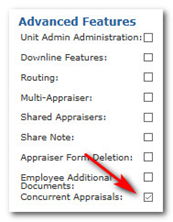
To activate Concurrent Appraisals, go to System Setup > Company Settings > Appraisal Settings tab, Advanced Features area and check the Concurrent Appraisals checkbox. Click Save on the blue toolbar. Once it is saved, an Appraisal Process submenu item will appear in the main menu under System Setup and a new Appraisal Process tab will appear on the Employee Data screen (for Administrative Users only.)

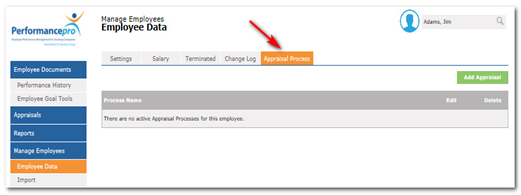
Customize the Name of the Default (Cycling) Appraisal – Administrative Users Only
If you activate Concurrent Appraisals, there will potentially be more than one appraisal open at a time for employees. For this reason, beginning with this release, appraisals will need to have a name to differentiate them from each other. The concurrent, non-cycling appraisals will be named by the Administrative User as part of their setup process. The name of the default (cycling) appraisal can now be customized on the System Setup > Company Settings > Custom Terms tab if Concurrent Appraisals is activated. Enter the singular and plural form of the name you’d like to give the default (cycling) appraisal. If you decide not to customize the name, it will be named “default appraisal.” Appraisal names will appear in applicable drop-down lists, pop-up messages, widgets, email notifications, reports, and screens.
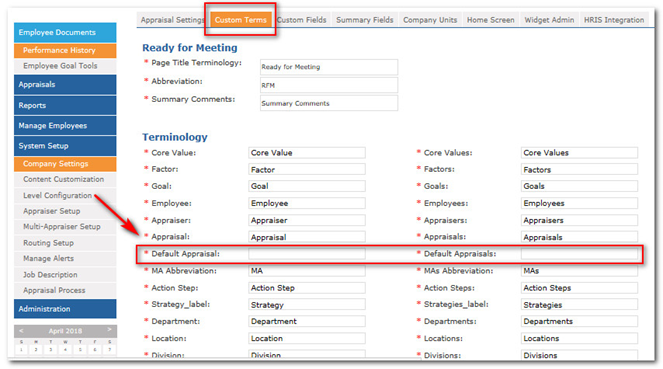
Creating a New Appraisal Process – Administrative Users Only
Process Name, Weights, and Options
The first steps to utilizing this feature, once it is activated, are to create the desired Appraisal Processes and then to assign the processes to employees. Administrative Users must assign the process to employees before an appraiser can select the process and perform the appraisal. Create a new Appraisal Process by clicking the Create Appraisal Process button on the System Setup > Appraisal Process > Appraisal Process tab.
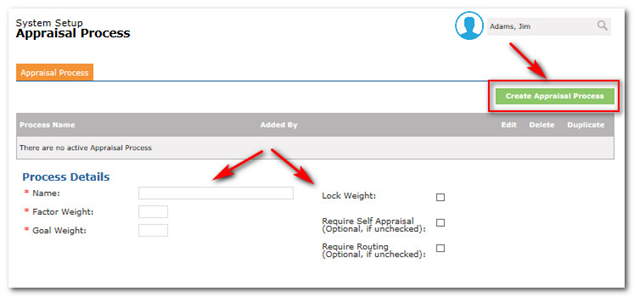
Enter a name for the Appraisal Process in the Name field. Ensure the name adequately describes the appraisal since it will appear in drop-down menus when choosing an appraisal to perform. It will also appear in applicable widgets, email notifications, pop-up messages, reports, and screens.
Enter the weights for Factors and Goals in the designated boxes. When you enter one weight, the other weight will auto-calculate to a total of 100%. If you don’t want appraisers to be able to change these weights when using the selected Appraisal Process, click the Lock Weight checkbox. If the weight is left unlocked, appraisers will be able to edit the distribution on the Employee Goal Tools screen.
If self-appraisals are optional or required in your system (established in Company Settings) you will see a Require Self-Appraisal checkbox. If you check the box, it will make self-appraisals a requirement on the selected Appraisal Process. If you leave it unchecked, they will be optional when using this Appraisal Process. If self-appraisals are disabled in Company Settings, there will be no Require Self-Appraisal checkbox.
If Routing is turned on in Company Settings, you will see a Require Routing checkbox. If you check the box, routing will be required when using the selected Appraisal Process. If you leave it unchecked, it will be optional when using the selected Appraisal Process.

Assign the Process to Employees
The Administrative User must assign the Appraisal Process to employees in order for the appraisal to be performed. The Select Employees table at the bottom of the screen is filled with active employees and information from their Employee Data screen. To assign employees to the Appraisal Process, click on a name from the Employees column and then click the single right green arrow to move the employee to the Assigned to Employees list. (You can also double click the name of the employee to move it.) You will receive a message instructing you to use the Assign Positions and Dates button in order to save the assignment of the Appraisal Process to the employee(s). You can use this button directly after you move each employee, or you can move all your employees and then assign the applicable positions and dates.
To unassign a process from an employee, click on the employee name in the Assigned to Employees list and click the single left arrow. This will move them back to the Employees list.
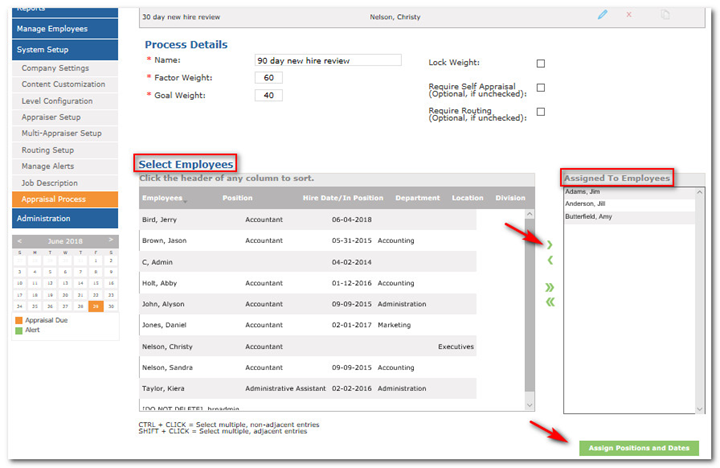
When you click the Assign Positions and Dates button, a pop-up box will appear where you will enter the appraisal start date, end date, due date, and self-appraisal due date (if applicable) for each employee to whom you assigned the selected Appraisal Process. If all the employees should have the same dates, you can enter the dates in the row above the gray box and click the Apply to All checkbox. This will copy the dates into each employees’ corresponding date fields.
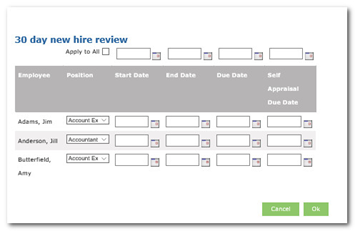
You must select the position with the associated Factors on which you wish to evaluate the employee for the selected Appraisal Process. In most cases, this may be the employee’s assigned job title. However, there may be circumstances for which a position with different Factors may be needed for a unique Appraisal Process. For example, you may evaluate your tellers on a different set of Factors at 30 days than you do on the annual appraisal. In this case, you could set up a “30-day Teller” position and a “Teller” position with the desired Factors for each Appraisal Process.
All fields must be populated before you will be able to save and leave the screen. Click OK to save the position and dates and leave the popup box or Cancel to leave the box without saving the position and dates. Click Save on the blue toolbar.
Note:
The appraiser will not be able to edit the position and dates or add any Appraisal Processes to an employee. Only Administrative Users have access to this.
The columns in the Select Employees table are sortable. If you click a column header, all data in the table will sort by that column. Date columns will sort chronologically (newest to oldest or reversible with a second click). Text columns will sort alphabetically (a-z or reversible with a second click). Employee Last Name, First Name will always sort secondarily in alphabetical order.
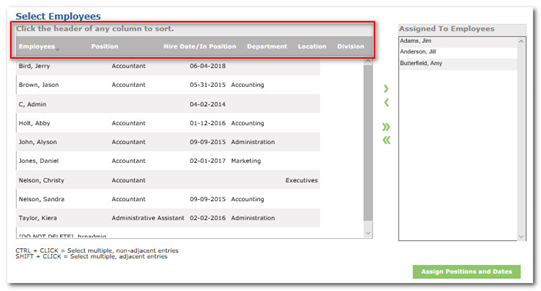
Editing, Duplicating, or Deleting Appraisal Processes – Administrative Users Only
Once an Appraisal Process is created, it can be edited, duplicated, or deleted. Following are a few guidelines for these functions:

- Edits made to any of the settings on the Appraisal Process will apply to all employees to whom the selected process is currently assigned.
- When editing an Appraisal Process, the Assign Positions and Dates button will be inactive, unless there is at least one person assigned to it. If there is at least one person assigned, the button is always active.
- When editing an Appraisal Process that has already been assigned to employees, the Position field cannot be changed. If a change to the Position field is necessary, the appraisal assignment will need to be removed from the employee.
- Clicking the Duplicate icon will duplicate all of the settings of the Appraisal Process but not the employees to whom it is assigned. The duplicated process will have “(copy)” at the end of the Appraisal Process name. Edit the name in the Appraisal Process Name field and click Save on the blue toolbar.
- The Delete icon will be inactive if there are any employees assigned to the Appraisal Process. You will not be able to delete it until all employees are either unassigned from it or the appraisals are completed.
- When an Appraisal Process is deleted, any completed instances of the deleted appraisal will remain in the Performance History of the employees to whom it is assigned.
Employee Data Appraisal Process Tab – Administrative Users Only
Once the Administrative User has created the Appraisal Process and assigned it to employees, the process will appear on the new Manage Employees > Employee Data > Appraisal Process tab for those employees. This tab is only viewable by the Administrative User.
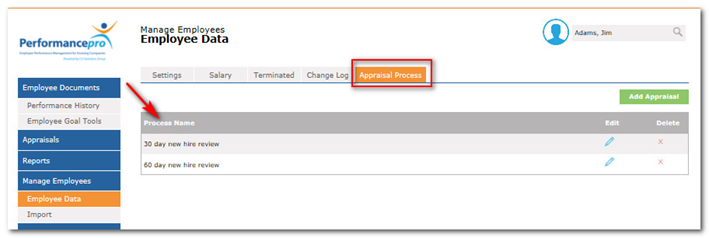
Note:
Only open appraisals will appear on the Appraisal Process tab of the Employee Data screen. Any Appraisal Processes that have been completed will appear in Performance History.
Add Another Appraisal Process to an Employee
If the Administrative User needs to add an additional Appraisal Process for the employee, they can click the Add Appraisal button and choose the desired process from the Appraisal Process Name dropdown menu. All Appraisal Processes previously created will appear in the dropdown. (If you have multiple employees to add to a process it’s quicker to use the Appraisal Process option from the System Setup > Appraisal Process screen.)
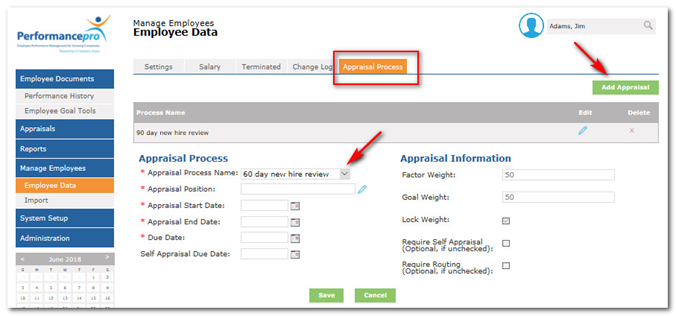
Once an Appraisal Process is selected, the Appraisal Information options for the process (weights, self-appraisals, and routing) will reflect what was set by the Administrative User during the process creation. The Appraisal Process Name field cannot be edited. Choose an Appraisal Position from the dropdown box. This is the position that will determine the factors that will apply to the selected Appraisal Process. Enter appropriate dates in all the date fields. Click the green Save button to add the process to the employee file. Once added, the Appraisal Process will appear for appraisers in dropdown menus in Employee Goal Tools (for adding and editing Goals) and on the Evaluate screens as part of the appraisal.
Edit Appraisal Process
To edit dates on an individually-assigned Appraisal Process, click the Edit icon beside the Appraisal Process name in the table. You can edit the following fields:
- Appraisal Start Date
- Appraisal End Date
- Appraisal Due Date
- Self-Appraisal Due Date
When all desired edits are made, click the Save button at the bottom of the screen or click the Cancel button to continue editing.
The Appraisal Information section displays read-only fields from the initial setup of the Appraisal Process by the Administrative User. These fields cannot be edited.
Delete an Appraisal Process
To delete an Appraisal Process from an employee, click the Delete icon beside its name in the table. (Be aware that deleting an Appraisal Process will remove any scores or comments in the appraisal.) Upon clicking Delete, you will receive the following message "Deleting this appraisal will remove all appraisal data from the appraisal and employee. Are you sure you want to continue?" Click Delete to proceed with the deletion or Cancel.
Performing an Appraisal Using a Concurrent Appraisal Process – Appraisers or Employees
Performing an appraisal using a Concurrent Appraisal Process is essentially the same as using the default appraisal. Because concurrent appraisals do not cycle, there will be no Last column on the evaluation screens and Future Goals cannot be assigned. To distinguish between multiple appraisals available for an employee, the appraisal screens will have a dropdown menu for you to select an appraisal with which you wish to work.

The dropdown menu options include the default appraisal and all concurrent appraisals assigned to the employee on the Employee Data > Appraisal Process tab. Select an appraisal and work through the Evaluate Factors, Evaluate Goals, Summary Comments, and Finish Appraisals screens as you would normally do.
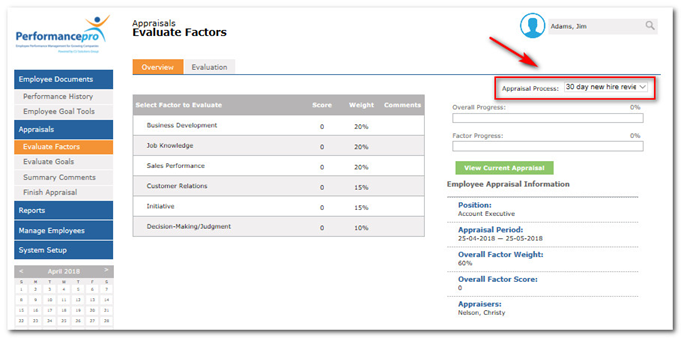
Employee Goal Tool – Appraisers or Employees (if applicable)
The Appraisal Process dropdown menu will appear on the Employee Goal Tools screens to select the appraisal with which you wish to work. The dropdown menu options include the default appraisal and all concurrent appraisals assigned to the employee on the Employee Data > Appraisal Process tab. You will not be able to enter any Goals until you select an Appraisal Process. If the employee only has one appraisal, it will be selected by default.

The Overall Goal and Factor Weights for the selected Appraisal Process will carry over from the weights assigned on the Appraisal Process tab in Employee Data. The weights may have been locked during the initial setup of the Appraisal Process in System Setup.
To add a Goal to the selected appraisal, click the Add Goal button and enter the Goal information as you normally would do. You can also copy Goals that exist in the default/cycling appraisal by clicking the Import from Default Appraisal button (the name of this button may have been customized). A popup box will appear that contains all the Goals from the current default appraisal. Clicking Yes will import all of them into the selected concurrent appraisal with which you are working. Delete any Goals you do not wish to include.
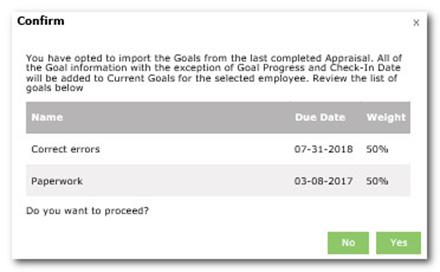
Note:
Because concurrent appraisals do not cycle, Future Goals cannot be included in this type of appraisal.
When working with a concurrent appraisal, you can also copy Goals to My Library (if this feature is activated), copy Goals to additional Appraisal Processes assigned to the selected employee, or copy Goals to other employees with the same assigned Appraisal Process. These actions are accomplished by selecting the desired Goal from the goal table and then using the buttons below the table.
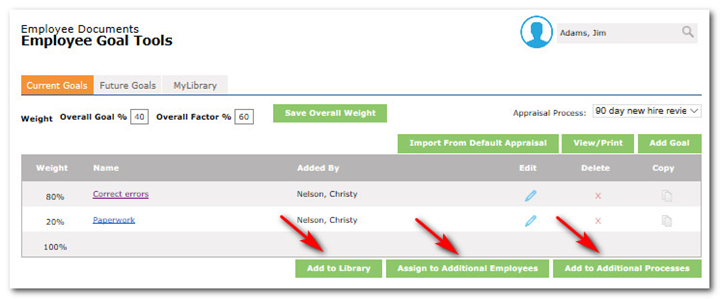
Clicking on the Assign to Additional Employees button will generate a popup box from which you can select additional employees to whom the Goal can be assigned. Select the employee and click the right green arrow to transfer the employee to the box on the right. The only employees who will be available for selection are those in your downline to whom the same concurrent appraisal has been assigned. Click OK when your selections are complete.
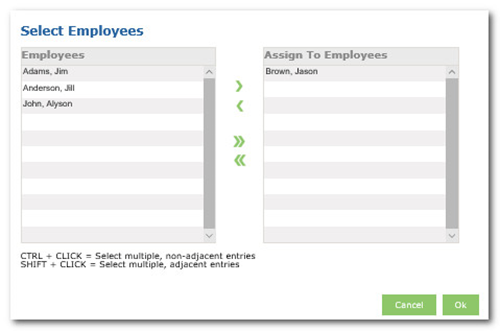
Clicking on the Add to Additional Processes button will generate a popup box from which you can select the additional Appraisal Processes assigned to that employee and to which the Goal can be assigned. Select the process and click the right green arrow to transfer the process to the box on the right. The only processes in the Processes box will be other concurrent Appraisal Processes assigned to the employee.

My Library – Appraisers or Administrative Users
If the My Library feature is active, Goals can be assigned to both default and concurrent appraisals. On the My Library tab, open the Goal you wish to assign. Click on the Assign to Appraisals button and then the Add button.
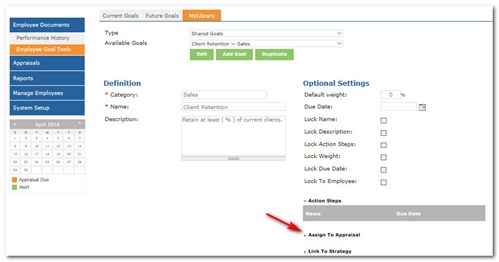

The Appraisal Process dropdown field will include a list of available Appraisal Processes. The default appraisal will be auto-selected. When the default appraisal is selected, radio buttons will appear to assign the Goal to either the Current Period or the Future Period.
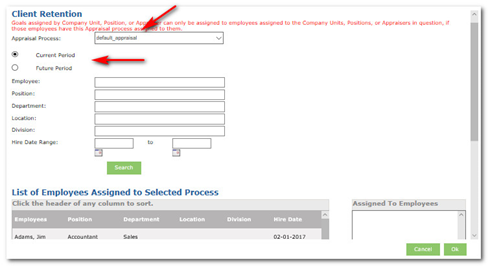
When a concurrent appraisal is selected, the radio button for Future Period will not appear because those appraisals do not cycle.
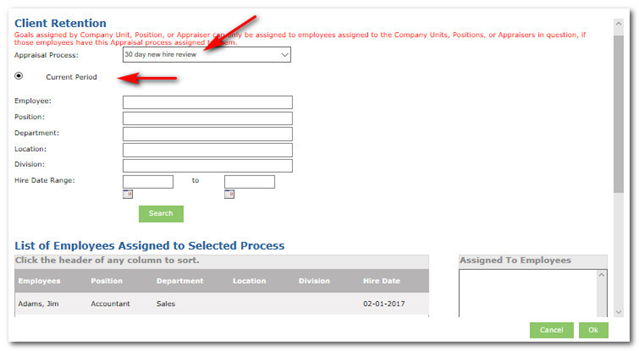
Note:
Goals assigned by Company Unit, Position, or Appraiser can only be assigned to other employees assigned to the same Company Units, Positions, or Appraisers, and with the same assigned Appraisal Process.
When an Appraisal Process is selected, the List of Employees Assigned to Selected Process table will display all employees to whom the selected Appraisal Process has been assigned and who are in the appraiser’s downline.
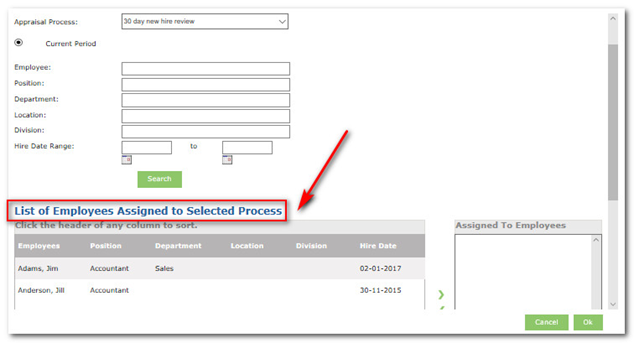
To filter the employees in the list, select any combination of search criteria. The search fields include Employee, Position, Department, Location, Division, and Hire Date Range. Click the Search button to generate the search results among employees to whom the selected Appraisal Process has been assigned.
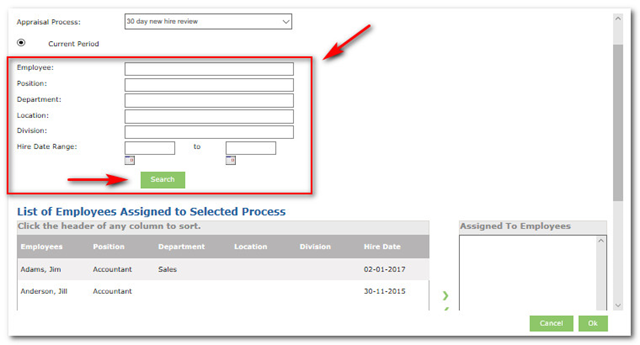
The columns in the List of Employees Assigned to Selected Process table are sortable. If you click a column header, all data in the table will sort by that column. Date columns will sort chronologically (newest to oldest or reversible with a second click). Text columns will sort alphabetically (a-z or reversible with a second click). A secondary alphabetical sort order will apply by Employee Last Name, First Name.
The user will be able to select the employee(s) and click the green arrows to move them to the Assigned to Employees box on the right to assign the Goal. Click OK and then click Save on the blue toolbar to save the Goal assignment.
Performance History
The Performance History screen will now include a column with the name of the appraisal to distinguish between cycling default appraisals and any non-default appraisals.

Email Notifications
E-mail notifications will now include the name of the appraisal to distinguish between cycling default appraisals and any non-default appraisals. By default, e-mail alerts set up from the System Setup > Manage Alerts tabs apply to default appraisals only. To apply these notifications to non-default appraisals (concurrent appraisals), the Apply to Non-Default Appraisals checkbox must be checked. This is located on the Manage Alerts > Appraisals tab and also on the Manage Alerts > Goals tab, Goal Alerts and Check-In Alerts sub-tabs.
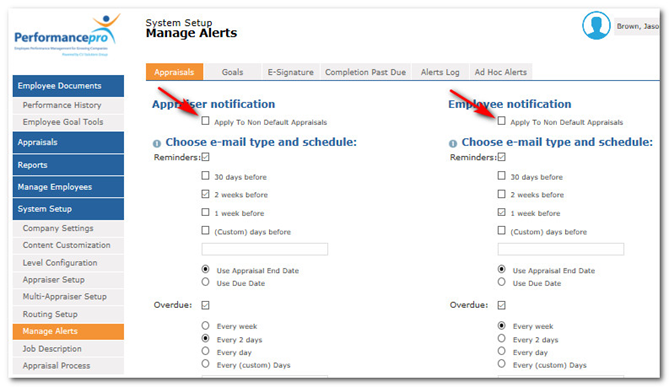
Import
Concurrent appraisal information can be included in the import process. The following details will apply:
- Once non-cycling Appraisal Processes have been created, the following fields will be subject to import: appraisal process name, appraisal start date, appraisal end date, appraisal due date, self-appraisal due date, overall goal weight, and overall factor weight.
- Non-cycling appraisals can be assigned to employees via import but cannot be deleted via import.
- If there is an existing appraisal assigned (of the same name), then the import will overwrite any weights and dates.
- If the Appraisal Process Name field is empty, no new appraisal will be assigned, unless a new employee is being entered. In this case, the import process will assign or update the default appraisal information.
- You can import any number of Appraisal Processes for the same employee within the same import.
- For instances of Performance Pro that are integrated with Compease, the process will require a more detailed import template.
- Only the default/cycling appraisals will feed into Compease. Non-cycling appraisals will not be applied within Compease merit matrices or the associated calculations and reports.
![HRPS Logo1.png]](https://knowledgebase.hrperformancesolutions.net/hs-fs/hubfs/HRPS%20Logo1.png?height=50&name=HRPS%20Logo1.png)